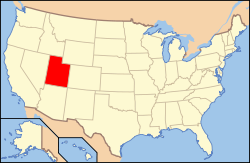Scofield, Utah
| Scofield, Utah | |
|---|---|
| Town | |

Historic Scofield Utah School building
|
|
 Location in Carbon County and the state of Utah |
|
 Location of Utah in the United States |
|
| Coordinates: 39°43′36″N 111°9′37″W / 39.72667°N 111.16028°WCoordinates: 39°43′36″N 111°9′37″W / 39.72667°N 111.16028°W | |
| Country |
|
| State |
|
| County | Carbon |
| Founded | 1879 |
| Named for | Mathew B. Scofield |
| Area | |
| • Total | 0.7 sq mi (1.8 km2) |
| • Land | 0.7 sq mi (1.8 km2) |
| • Water | 0.0 sq mi (0.0 km2) |
| Elevation | 7,739 ft (2,359 m) |
| • Density | 34/sq mi (13.2/km2) |
| Time zone | Mountain (MST) (UTC-7) |
| • Summer (DST) | MDT (UTC-6) |
| ZIP code | 84526 |
| Area code(s) | 435 |
| FIPS code | 49-67990 |
| GNIS feature ID | 2413267 |
Scofield is a town in Carbon County, Utah, United States. The population was 23 at the 2010 census. Scofield's name is frequently applied to the 1900 mine disaster in the Pleasant Valley Coal Company's Winter Quarters mine. The community was named for General Charles W. Scofield, a timber contractor and local mine official. It is the smallest incorporated area in Utah by population.
The town of Scofield is situated on high ground two miles south of the reservoir of the same name, the oldest and largest of the major impoundments on the Wasatch Plateau. Once the most populous community in Carbon County, Scofield has shrunk to only a few permanent residents. What has slowed the continual decline has become outsiders constructing summer vacation homes. The old brick school stands empty at the upper end of town, and there are abandoned buildings scattered through what was once the business district. Only the cemetery on a hill to the east suggests that this was once a community of some size. Visitors to the cemetery quickly become aware of the diverse ethnicity that populated the town.
Due to the luxuriant growth of the native grasses indigenous to this region, this valley was first utilized as pastures for the immense herds of cattle that came from Utah Valley. Among the first settlers of this region were S. J. Harkness, T. H. Thomas, William Burrows, O. G. Kimball, D. D. Green, A. H. Earll, R. McKecheney, who were attracted by the immense ranges for their cattle.
Coal was discovered in the valley in 1875, and two years later a small mine was opened on the western slopes of the canyon, with the coal transported out along narrow roads. The winter of 1877 came early and was very severe, stranding the miners in the coal pit and keeping them snowbound until the following February. The ordeal led the miners to name their forced camp "Winter Quarters". It became one of the first commercial coal mines in the state. Most of the first miners at the Winter Quarters were Mormon converts from the coal districts of Wales, England and Scotland. One of them, David Williams, leased the Winter Quarters Mine from the Pleasant Valley Coal Company from 1880 to 1885, operating in the dual capacity of mine manager and bishop of the local LDS ward. When the Rio Grande Western Railway acquired the coal company, they undertook the development of a new mine on Mud Creek, a mile from Winter Quarters, much to the chagrin of Williams, who protested that the new mine infringed on his lease. Because Bishop Williams controlled the Mormon miners, the Pleasant Valley Coal Company brought in Chinese laborers to work the Mud Creek mine. Soon a large contingent of Finns were recruited, along with Italian, Greek, and other Scandinavian workers.
...
Wikipedia
